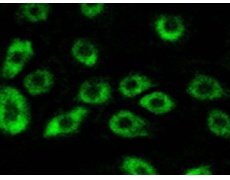中文名稱:兔抗ATP5D多克隆抗體
|
Background: |
Mitochondrial membrane ATP synthase (F1F0 ATP synthase or Complex V) produces ATP from ADP in the presence of a proton gradient across the membrane which is generated by electron transport complexes of the respiratory chain. F-type ATPases consist of two structural domains, F1 - containing the extramembraneous catalytic core, and F0 - containing the membrane proton channel, linked together by a central stalk and a peripheral stalk. During catalysis, ATP turnover in the catalytic domain of F1 is coupled via a rotary mechanism of the central stalk subunits to proton translocation. Part of the complex F1 domain and of the central stalk which is part of the complex rotary element. Rotation of the central stalk against the surrounding alpha3beta3 subunits leads to hydrolysis of ATP in three separate catalytic sites on the beta subunits. HAMAP-Rule MF_00530 |
|
Applications: |
IHC, IF |
|
Name of antibody: |
ATP5D |
|
Immunogen: |
Synthesized peptide derived from internal of human ATP5D. |
|
Full name: |
putative transcriptional regulator slyA-like, MarR family |
|
Synonyms: |
0 |
|
SwissProt: |
P30049 |
|
IHC positive control: |
Human lung carcinoma tissue |
|
IHC Recommend dilution: |
50-100 |
|
IF positive control: |
A549 cells |
|
IF Recommend dilution: |
100-500 |


 購物車
購物車 幫助
幫助
 021-54845833/15800441009
021-54845833/15800441009
